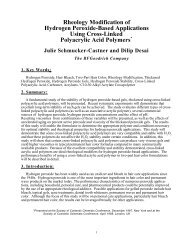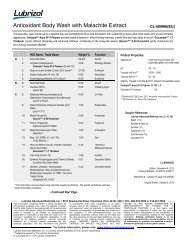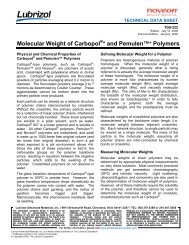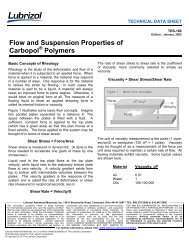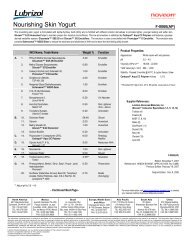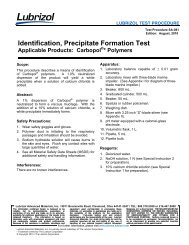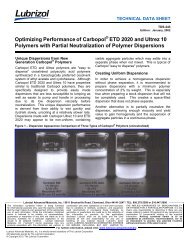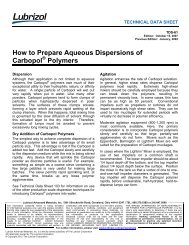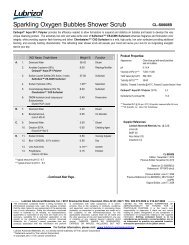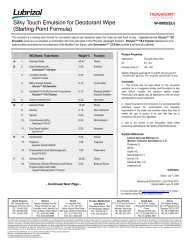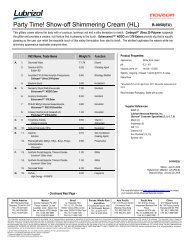Formulating Hydroalcoholic Gels with Carbopol Technical ... - Lubrizol
Formulating Hydroalcoholic Gels with Carbopol Technical ... - Lubrizol
Formulating Hydroalcoholic Gels with Carbopol Technical ... - Lubrizol
Create successful ePaper yourself
Turn your PDF publications into a flip-book with our unique Google optimized e-Paper software.
Formulation and Manufacturing Guidelines<br />
• Typical hand sanitizing gels contain less that 40<br />
wt% water. Due to this formulation constraint, a<br />
common concern is how to effectively incorporate<br />
the <strong>Carbopol</strong> polymer. The general methods are<br />
outlined as follows, dependent on your choice of<br />
polymer:<br />
Direct Method: The direct method is the traditional<br />
method for dispersing <strong>Carbopol</strong> polymers.<br />
<strong>Carbopol</strong> Ultrez Polymers: This method is made<br />
easy <strong>with</strong> <strong>Carbopol</strong> Ultrez polymers since you simply<br />
sprinkle the polymer on the surface of the water.<br />
Allow the polymer to self wet and then begin<br />
agitation. The general procedure is described as<br />
follows:<br />
1. Disperse the polymer into the water. Mix until<br />
smooth to insure a lump free dispersion is<br />
obtained.<br />
2. Slowly add the alcohol <strong>with</strong> agitation and mix until<br />
homogeneous.<br />
3. Add emollients if desired. Keep in mind that the<br />
order of addition may be critical to maintain<br />
product clarity. See “Adding Emollients” for<br />
further information.<br />
4. Add the appropriate neutralizing agent <strong>with</strong> gentle<br />
sweeping agitation and mix until smooth.<br />
NOTE: If production equipment constraints require<br />
the water and alcohol to be combined before the<br />
dispersion of polymer, the <strong>Carbopol</strong> Ultrez polymers<br />
must be dispersed like a traditional polymer. The<br />
<strong>Carbopol</strong> Ultrez grade polymers will not self wet in a<br />
solution of water and alcohol.<br />
<strong>Carbopol</strong> Traditional Grade Polymers: These<br />
polymers can be dispersed in either the water or<br />
alcohol/water mixture. The polymer will swell more<br />
slowly when added to the alcohol/water mixture, so<br />
care must be taken to avoid the clumping and<br />
skinning of the polymer during the dispersion<br />
process.<br />
1. Carefully disperse the polymer in the water or<br />
water/alcohol mixture <strong>with</strong> good agitation. High<br />
mixing speeds are generally preferred as it<br />
prevents agglomeration of the polymer on the<br />
surface of the water. Mix until the polymer is<br />
hydrated and the dispersion is smooth and free of<br />
lumps.<br />
TDS-255<br />
<strong>Formulating</strong> <strong>Hydroalcoholic</strong> <strong>Gels</strong> <strong>with</strong> <strong>Carbopol</strong> ® Polymers<br />
Page 5 of 6<br />
2. Add the alcohol <strong>with</strong> slow mixing to de-aerate the<br />
formulation if it was not included in Step 1.<br />
3. Add emollients if desired. Keep in mind that the<br />
order of addition may be critical to maintain<br />
product clarity. See “Adding Emollients” for<br />
further information.<br />
4. Add the appropriate neutralizing agent <strong>with</strong> gentle<br />
sweeping agitation and mix until smooth.<br />
• Water Source: Use deionized water. <strong>Carbopol</strong><br />
polymers are sensitive to hard water ions,<br />
therefore, the clarity and viscosity may be<br />
negatively affected if regular tap water is used. If<br />
deionized water is unavailable, add a chelating<br />
agent such as tetrasodium EDTA at a level of<br />
about 0.05-0.10% (wt/wt%).<br />
• Adding Emollients: Several commercially<br />
available emollients can be added to the hand<br />
sanitizing gel to compensate for removal of oils<br />
on the hands by the alcohol. The following watersoluble<br />
emollients can be added directly to the<br />
water and polymer dispersion or just before<br />
neutralization. The use of these emollients from<br />
0.3-0.5 wt% addition will not impact the final<br />
product clarity.<br />
Trade Name INCI Name<br />
Glucam E-20 Humectant Methyl Gluceth-20<br />
Glucam E-10 Humectant Methyl Gluceth-10<br />
SilSense Copolyol-1 Silicone PEG-33 and PEG-8<br />
Dimethicone and PEG-14<br />
SilSense SW-12 Silicone Ester Dimethicone PEG-7 Cocoate<br />
Hydramol PGPL Emollient PEG/PPG-8/3 Laurate<br />
Hydramol PGDS Emollient PEG-90 Diisostearate<br />
The Hydramol emollients can be added at use<br />
levels from 0.5-3.0 wt% and still maintain good clarity<br />
in the system.<br />
The use of other emollients may impact the final<br />
product clarity depending on the solubility profile of<br />
that particular emollient. Other emollients, such as<br />
isopropyl myristate, may need to be added to the<br />
alcohol and the water/polymer dispersion added to<br />
the alcohol/emollient phase to maintain final product<br />
clarity.




